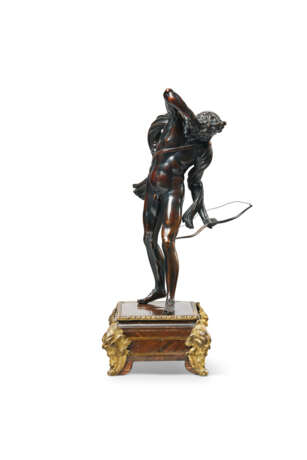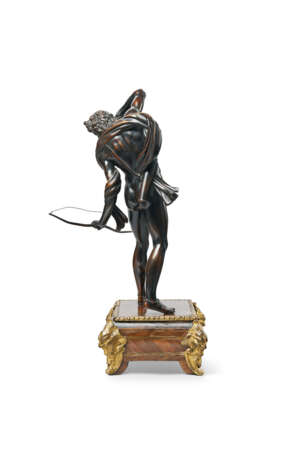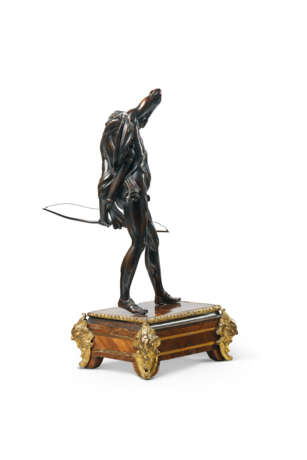ID 1230042
Lot 7 | D'APRÈS UN MODÈLE ATTRIBUÉ À FERDINANDO TACCA (1619-1686), PROBABLEMENT ITALIE, XVIIIe SIÈCLE
Estimate value
€ 10 000 – 15 000
Apollon tuant le serpent Python
bronze, reposant sur un socle de style Régence en marqueterie de bois et filets de laiton à décor de masques de satyre en bronze doré ; le serpent Python probablement initialement manquant
H. 33,8 cm (13 1/3 in.) ; H. totale 43 cm (17 in.)
Provenance
Collection privée, Paris.
Literature
Bibliographie comparative :
A. Radcliffe, « Ferdinando Tacca, The Missing Link in Florentine Baroque Bronzes », in Kunst des Barock in der Toskana, Munich, 1976, pp. 14-23.
K. A. Möller, Elfenbein: Kunstwerke des Barock, cat. Staatliches Museum Schwerin, Schwerin, 2000, pp. 116-117, no. 65.
J. Warren (dir.), Beauty and Power: Renaissance and Baroque Bronzes from the Peter Marino Collection, cat. expo. The Wallace Collection, London, The Huntington Art Collections, San Marino, and the Minneapolis Institute of Arts, Minneapolis, London, 2010, pp. 114-127, no. 10.
R. Seelig-Teuwen, « Guillaume Berthelot as a Sculptor of Small Bronzes », in J. Warren (ed.), Renaissance and Baroque Bronzes in and around the Peter Marino Collection, London, 2013, pp. 29-41.
Further Details
A BRONZE FIGURE REPRESENTING APOLLO SLAYING THE PYTHON, AFTER A MODEL ATTRIBUTED TO FERDINANDO TACCA (1619-1686), PROBABLY ITALIAN, 18TH CENTURY
While this bronze -some examples of which are entitled Jason, Apollo or simply Warrior - has long been part of a series of statuettes attributed to Ferdinando Tacca (1619-1686), it has recently been suggested that the model, or at least some of the casts, may be French, without ruling out the possibility of an Italian origin.
The subject depicted here captures the moment just before Apollo kills Python, the serpent or dragon that presides over the Delphic oracle in Greek mythology. The young god in the group, certainly inspired by an engraving illustrating Ovid's Metamorphoses by the Florentine engraver Antonio Tempesta (1555-1630, MET, inv. no. 51.501.3860), is shown in a dynamic pose, dressed only in a flowing cloak and pointing his bow at the beast that is absent from the composition.
Our example adds to the corpus of five known bronzes. Three of them, including ours, do not include Python (Hermitage, Saint Petersburg, inv. no. N.SK.221; Yves Saint Laurent and Pierre Bergé collection, then Christie's, Paris, 23-25 February 2009, lot 586), unlike the three other examples in which the archer points his arrow at the dragon (one from the former Julius Goldschmidt collection, another from the Peter Marino collection, and the last sold at Sotheby's, London, 3 July 2018, lot 79).
There is little documentation on Ferdinando Tacca's bronzes, and it was Antony Radcliffe who first attributed this model to Tacca. In his article "Ferdinando Tacca, The Missing Link in Florentine Baroque Bronzes", published in 1976, Radcliffe first associated the Apollo with Tacca's work, likening it to the male figure in the sculpted group Roger et Angélique (Musée du Louvre, inv. no. OA 7811) attributed to the sculptor. While in general the elongated, slender figures bear witness to a strong Florentine Mannerist heritage, Jeremy Warren suggested in 2010 that this attribution should be reconsidered. He preferred a French origin for the model, in particular because of its association with a figure of Diana attributed to the French sculptor Guillaume Berthelot (c. 1583-1648). In 2013, this latter proposal was called into question by Regina Seeling-Teuwen, who supported the possibility of an Italian origin for the subject.
This model represents an important addition to the study of 17th-century bronzes between Italy and France.
| Artist: | Ferdinando Tacca (1619 - 1686) |
|---|---|
| Applied technique: | Metalwork |
| Medium: | Bronze, Wood |
| Genre: | Mythological painting |
| Place of origin: | Italy, Europe |
| Auction house category: | All other types of objects, Sculptures, Statues & Figures, Statuettes |
| Artist: | Ferdinando Tacca (1619 - 1686) |
|---|---|
| Applied technique: | Metalwork |
| Medium: | Bronze, Wood |
| Genre: | Mythological painting |
| Place of origin: | Italy, Europe |
| Auction house category: | All other types of objects, Sculptures, Statues & Figures, Statuettes |
| Address of auction |
CHRISTIE'S 9 Avenue Matignon 75008 Paris France | ||||||||||||||
|---|---|---|---|---|---|---|---|---|---|---|---|---|---|---|---|
| Preview |
| ||||||||||||||
| Phone | +33 (0)1 40 76 85 85 | ||||||||||||||
| Fax | +33 (0)1 40 76 85 86 | ||||||||||||||
| Conditions of purchase | Conditions of purchase | ||||||||||||||
| Shipping |
Postal service Courier service pickup by yourself | ||||||||||||||
| Payment methods |
Wire Transfer | ||||||||||||||
| Business hours | Business hours
|














